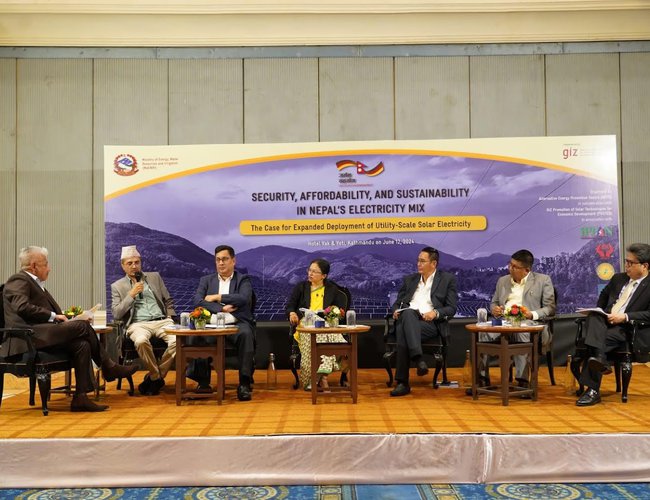
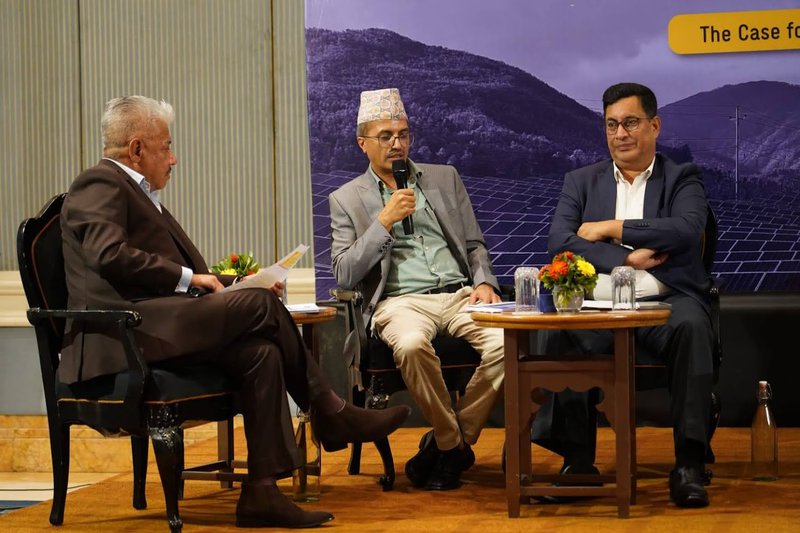
As the costs of solar photovoltaic (PV) systems are decreasing and becoming more affordable worldwide, there is broad consensus among officials, businesses, and development partners in Nepal about the need to promote solar power to enhance the country's electricity security, affordability, and sustainability.
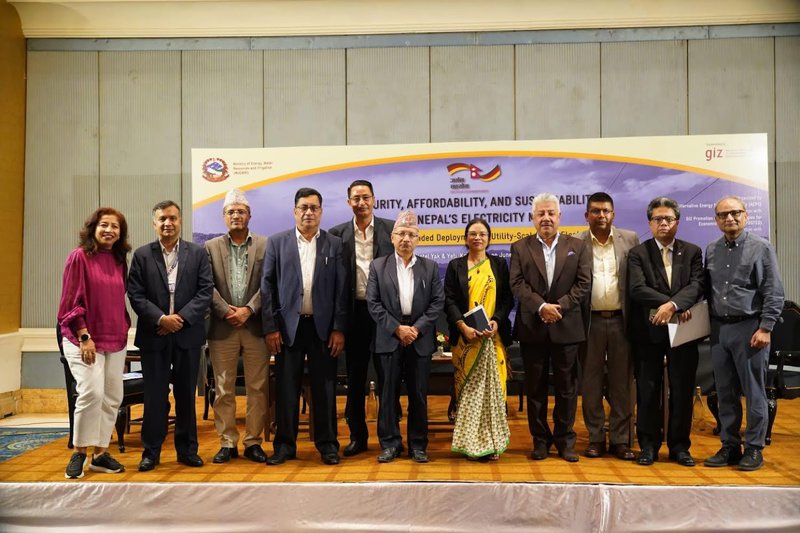
Yet, there are discrepancies, particularly concerning the tariff for solar power. A study, supported by GIZ, a German organization specializing in international cooperation for sustainable development and the German government, found that solar power is a viable option for the country's electricity mix. The report also suggested increasing the current solar power tariff to match the national electricity tariff in Nepal.
Given that Nepal's electricity system is heavily reliant on hydropower, there are significant risks associated with energy security, reliability, and affordability. Recent data shows that Nepal has a total of 144 hydropower plants capable of generating 2625 MW of power and 13 solar plants with a capacity of 93 MW.
The Department of Electricity Development has granted licenses for 249 hydropower projects, totaling 9601 MW, and 14 MW solar projects, with a capacity of 72 MW. So far, 104 hydropower projects have applied for generation licenses under the Department of Electricity Development, with a combined capacity of 11,069 MW, and 7 solar projects with a capacity of 51 MW. However, the Department of Electricity Development has issued survey licenses for 88 hydropower projects with a combined capacity of 8442 MW and 32 solar projects with a capacity of 662 MW.
Except for Kulekhani I, II, and III, which have capacities of 60, 32, and 14 MW, respectively, all hydropower projects in Nepal are of the run-off-the-river (RoR) type, and there are variations in energy production between the dry and wet seasons.

"Nepal's electricity sector is facing significant challenges, with the most pressing being its over-reliance on hydropower. The electricity generation mix in Nepal is dominated by hydropower, accounting for 95 percent of the installed capacity, with most of them being run-off-the-river (RoR) type," said Professor Dr. Shaligram Pokharel, who led the study, presenting the key findings. "At a time when Nepal has committed to achieving clean energy by 2045 through its Nationally Determined Commitment, the country cannot afford to rely on non-renewable sources of electricity, such as fossil fuels, but must embrace renewable energy sources like solar, wind, and clean biomass."
"Nepal has achieved significant advancements in enhancing the capacity for generating, transmitting, and distributing electricity, thereby ending the decade-long period of power outages," stated Pokharel during a joint program organized by the Alternative Energy Promotion Center and Giz in the presence of various stakeholders including government officials, private sector representatives, and experts.
The report was titled "The Role of Solar Energy in Achieving Energy Security, Reliability, and Sustainability." Professor Dr. Pokharel, the lead author, underscored the importance of promoting solar energy for its potential in ensuring energy security, reliability, and sustainability. In his presentation, he emphasized the significance of solar power in diversifying the energy mix and suggested an adjustment in the existing tariff structure to attract more participation from the private sector.
While the Nepal Government has set a fixed rate of Rs.7.30 per unit for power purchase agreements for solar projects under the Grid Connected Renewable Energy Development Directives 2017.
Given the substantial reduction in the global prices of photovoltaic (PV) panels and the decrease in the construction costs of projects, the Electricity Regulatory Commission (ERC) on the advice of the Nepal Electricity Authority (NEA) reduced the tariff to Rs.5.94 per unit in April 2021. A lawsuit filed by the Solar Energy Producer Association by the Supreme Court backed the ERC's reduced tariff rate.
Similarly, the Nepal Electricity Authority (NEA) is purchasing power at an average of Rs.4.80 per kWh in the summer and Rs.8.40 in the winter from these renewable energy projects. However, the average cost of purchasing power from India has fallen to Rs.10.48 per kWh, with peak prices reaching as high as Rs.32 per KWh.
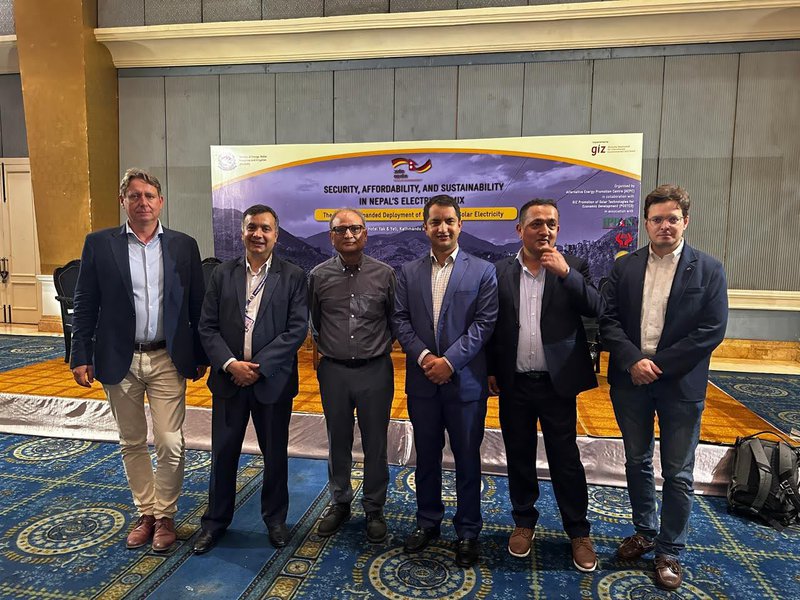
As Professor Dr. Pokharel suggested a rise in the tariff in line with the cost of hydropower, senior officials from the Ministry of Energy, ERC, and NEA defended the current tariff, stating that it is considerably lower than the risk involved in the investment in solar energy. They argued that solar energy is now significantly cheaper on a global scale, and therefore, the tariff should also be revised accordingly.
"Following comprehensive research conducted by experts from both the Nepal Energy Authority and the government, the current tariff has been set considering international practices to take into account the costs of the project, loans, depreciation, equity debt, return on equity, general operating and maintenance costs, revenue, taxes, additional capital, and other factors, making it a better offer than the tariff in India," stated Navin Kumar Singh, Joint Secretary of the Ministry of Energy, Water Resources, and Irrigation. He further questioned the purpose of the report that highlighted the need for a tariff revision.
However, Kuber Mani Nepal, the Managing Director of Ridi Power Company Ltd and the backer of 8.5 MW solar power plants, criticized the current tariff, stating that it is discouraging foreign and domestic investors from entering the solar energy sector.
"Professor Pokharel has accurately identified the reasons behind the sluggish growth in the solar power sector,” Nepal pointed out. "We believe there is a need for a revision in the tariff structure as per the case of hydropower projects."
Despite differing opinions on the existing tariff for solar power among private companies, both the presenter of the report, the National Energy Authority (NEA), and the government officials agree on the importance of integrating solar power into a mix with hydropower.
During his presentation, the Professor highlighted the aspects of electricity generation and demand, renewable options aside from hydropower, the significance of solar power in electricity production, patterns of electricity use and supply, the cost and efficiency of solar technologies, the availability of solar resources, and how solar power can complement hydropower and energy storage solutions.
Man Devi Shrestha, the secretary at the Electricity Regulatory Commission, explained that the pricing for electricity has been determined with consideration for the consumer while also safeguarding the investments made by the private sector.
The Professor pointed out that the majority of hydropower is still coming from traditional hydropower sources, excluding the Kulekhani cascade 104 MW. Despite an increase in power from independent power producers (IPPs), the reduction in hydropower generation during the dry season is a concern. There is also a worry regarding the potential increase in electricity demand due to higher per capita electricity consumption, the need for energy-efficient industrial upgrades, and the impact of rising temperatures on electricity demand during the dry season, which is accompanied by a challenge in matching supply and demand.
It was noted that while options exist, there are uncertainties in scaling up solar energy exploitation. Currently, Nepal's main source of electricity is through sugar industries, which is seasonal and has a capacity of only 6 MW out of a potential 100 MW from 12 mills. Wind energy is at the early stages of development.
Among renewable energy sources, the use of solar energy is on the rise globally, including in Nepal. The Professor noted that the cost of generating solar energy has significantly decreased in recent years, with the generation cost per kilowatt-hour dropping from $0.445 in 2010 to just $0.049 in 2022, an 89% reduction. He also mentioned the increase in the efficiency and size of solar panels, as well as the technology used to enhance solar panel absorption capabilities. It was projected that about 40% of Nepal's land area is capable of producing an average of 1400 kilowatt-hours per kilowatt.
In his proposal for course correction, Professor Pokharel recommended adjusting the limit on electricity production from non-hydro sources. He argued that the existing 10% benchmark hinders the potential for economies of scale and suggests allowing the market to naturally evolve.
“Solar energy offers Nepal a pathway to ensure electricity security at a cost that is both affordable and dependable,” said Singh, the Joint Secretary of the Ministry of Energy, Water Resources, and Irrigation. “The government of Nepal has a definitive strategy for solar energy,” he added. “As the price of solar panels continues to decrease, it is crucial that investors offer electricity at more competitive rates to consumers. The tariff established by the government is designed to provide investors with profits and to offer consumers relief.”
The research indicates that solar energy is a viable and supplementary source for electricity. As the technology's ability to produce and the cost to produce it locally improves, its potential becomes even more significant.
The demand for electricity could see significant shifts. Should the government approve the private sector's ability to export electricity to India, the landscape would be altered. This scenario is even more likely if the export is necessary (due to commitments), as it would shift the dynamics of the country's electricity supply, emphasizing the speed at which solar photovoltaic (PV) systems can be implemented.
"The information provided is drawn from research carried out under the Promotion of Solar Technologies for Economic Development (POSTED) initiative, a joint effort by the Alternative Energy Promotion Center (AEPC) and giz," Professor Pokharel noted.
The start of the session
In her introductory comments, Paulina Campos Monteros, the deputy country director of giz, mentioned that the study will assist Nepal in formulating the right energy mix policy based on solar.
Emphasizing the significance of solar and renewable energy sources for ensuring energy security and access, Nava Raj Dhakal, the Executive Director of AEPC, pointed out that Nepal has given priority to solar energy in its Renewable Energy Policy. Dhakal highlighted that solar is the most practical and readily available option for diversification.
Given the current dominance of hydropower, Dhakal noted that hydropower accounts for approximately 95% of the nation's total installed capacity, with only 5% coming from solar and other renewable sources. He called for a change in this trend.
Even though numerous individuals and organizations have studied Nepal's potential in hydropower, a similar depth of analysis for solar power has been lacking. The study by giz on solar energy stands out as one of the most extensive and credible.
Thanks to the backing from the Agency for Energy Production and Conservation (AEPC), a collection of projects with a combined capacity close to 100 MW have been built and are now operational in remote locations without grid access.
The Department of Electricity Development (DoED) has authorized the commencement of feasibility studies for the production of solar power across 33 projects, a total of 662 MW.
Present Situation in Nepal
The aim of Nepal is to increase the proportion of solar, wind, biomass, and other renewable energy sources to 10 percent within the energy distribution mix by 2030.
Opinions vary on the necessity for Nepal to expand its range of energy sources to secure energy supplies, especially since the country is at risk of earthquakes and landslides, which could interrupt operations of hydropower facilities.
Meanwhile, the business sector has raised doubts about the government's dedication to promoting solar energy. "In March, the Nepal Electricity Authority chose to reduce the cost it is willing to pay for solar energy as the state-owned utility plans to source solar power through open bidding," mentioned Nepal. He mentioned that the authority has set a cap on the rate at which it will purchase solar energy, up to only Rs5.94 per unit.
"Given the decreasing prices of solar energy globally, the Nepal Electricity Authority decided to lower the prices it is willing to pay for solar energy,” stated Ghimire.
However, the producers of solar power are expressing concerns about the increased costs of solar panels and equipment due to global supply shortages and the conflict in Ukraine. "Investors might have to wait for 15 to 20 years to recoup their investments,” said Bharat Kumar Malla, the senior vice-president of the Solar Electric Manufacturers Association Nepal, questioning the government's support for solar energy. He added that potential investors might reconsider committing to solar projects in Nepal.
In November 2020, the cost of solar energy in India reached a record low of INR 2 per unit through competitive bidding. However, in recent times, there has been an increase in the expenses associated with the installation of solar plants.
In certain areas of the solar market, prices have risen as much as 18 percent in the past year, according to the report, quoting figures from the Solar Energy Industries Association and Wood Mackenzie.
Malla noted that escalating costs of raw materials are making the operation of solar plants unattractive for the Nepal Electricity Authority, as the authority has opted to lower the prices it is willing to pay to developers.
Business sector has argued that the government needs to create an environment that is predictable to attract investment in the solar energy sector. "The Nepal Electricity Authority could pay current rates to those who have already invested in solar projects while providing lower rates to those who are yet to invest," suggested Nepal.
Despite advocating for hydropower, the government is also prioritizing solar electricity to ensure a secure energy supply. "The decreasing costs of solar energy over the last ten years have made it a more affordable option for our nation's energy needs," stated Singh, a spokesperson for the Energy Ministry.
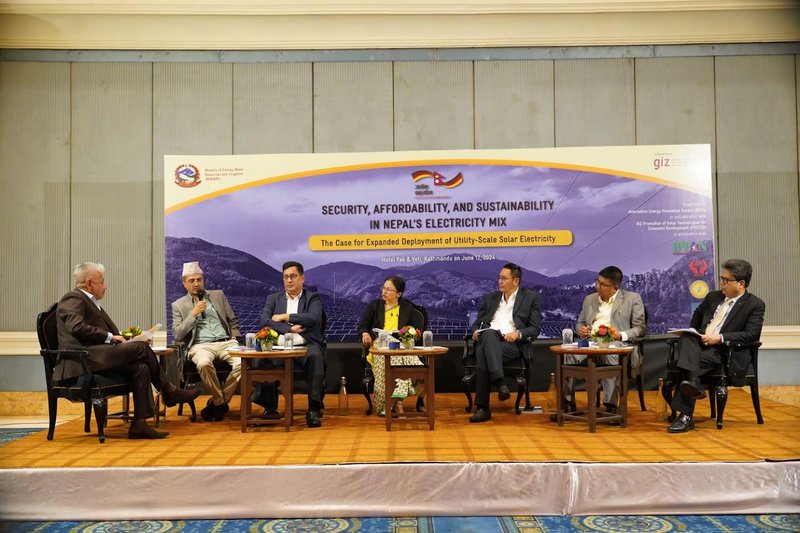
Nepal has a significant potential for solar energy, much of which remains unexploited. The government and the public-private sector must work together to fully leverage this cost-effective renewable energy source.
Solar energy in Nepal offers a promising way to diversify the nation's energy mix. The country's current electricity supply is nearly all dependent on hydropower, which is vulnerable to changes in weather patterns, like shifts in rainfall, and the effects of climate change, such as less snowmelt.
This vulnerability underscores the importance of solar energy in Nepal for stabilizing and expanding the domestic renewable energy supply. Moreover, it introduces the opportunity to develop an energy export economy for the country, which could be crucial in improving the historically low per-capita GDP and the stagnant export sector.
Focusing on investment and growth in the solar sector could be a way for Nepal to enhance its energy security, lower its carbon emissions, and improve the living conditions of its people.
Nepal is believed to have the potential to generate 50,000 TWhs of solar energy each year, which is 7,000 times more than the country uses today. Yet, Nepal's solar energy sector is still in its infancy, and only a small portion of this potential is being utilized. The country currently has around 55 MW of solar capacity, which annually produces over 133 GWh of energy, representing just over 1% of the nation's total electricity output.
The Renewable Energy Subsidy Policy plays a key role in this initiative by providing financial support and incentives to encourage the installation of solar panels by individuals and communities. These subsidies include coverage for various solar technologies, including photovoltaic systems and solar water heaters, making renewable and sustainable energy solutions more widely available to the population.
In addition to subsidies, there has been a push for more support mechanisms, such as tax breaks. These policy initiatives aim to attract more investment in solar technology, lower the costs of solar projects, and position solar energy as a more competitive option to traditional power sources.
As Nepal moves forward with its solar energy efforts, there are both opportunities and challenges ahead. The growth of solar capacity not only contributes to the nation's energy security but is also a key part of Nepal's strategy to adapt to and mitigate climate change, and a vital step in reducing greenhouse gas emissions.
"The recent drop in solar panel prices, along with innovative solutions like agri-voltaic and floating PV that reduce the need for land use, open the door to a clean, sustainable, and reliable electricity sector in Nepal. However, for the sector to truly flourish, policies must be equitable and create a stable environment for private sector investment," said professor Pokharel.

Keshab Poudel
Poudel is the editor of New Spotlight Magazine.
- ETFC Nepal is focused on expanding distribution and transmission to the private sector: ETFC Chair Dr. Dhital
- Jul 05, 2025
- FOURTH PROFESSOR Y.N. KHANAL LECTURE: Nepal-China Relations
- Jun 23, 2025
- Colonel JP CROSS: Centenary Birthday
- Jun 23, 2025
- REEEP-GREEN: Empowering Communities with MEP
- Jun 16, 2025
- BEEN: Retrofitted For Green
- May 28, 2025















